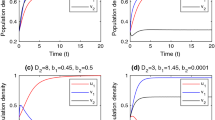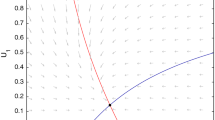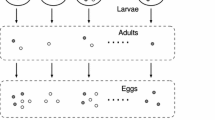Abstract
This paper considers two-species competitive systems with two patches, in which one of the species can move between the patches. One patch is a source where each species can persist alone, but the other is a sink where the mobile species cannot survive. Based on rigorous analysis on the model, we show global stability of equilibria and bi-stability in the first octant Int\(R_+^3\). Then total population abundance of each species is explicitly expressed as a function of dispersal rates, and the function of the mobile species displays a distorted surface, which extends previous theory. A novel prediction of this work is that appropriate dispersal could make each competitor approach total population abundance larger than if non-dispersing, while the dispersal could reverse the competitive results in the absence of dispersal and promote coexistence of competitors. It is also shown that intermediate dispersal is favorable, large or small one is not good, while extremely large or small dispersal will result in extinction of species. These results are important in ecological conservation and management.





Similar content being viewed by others
References
Andren H (1994) Effects of habitat fragmentation on birds and mammals in landscapes with different proportions of suitable habitat: a review. Oikos 71:355–366
Arditi R, Lobry C, Sari T (2015) Is dispersal always beneficial to carrying capacity? New insights from the multi-patch logistic equation. Theor Popul Biol 106:45–59
Arditi R, Lobry C, Sari T (2018) Asymmetric dispersal in the multi-patch logistic equation. Theor Popul Biol 120:11–15
Aström J, Pärt T (2013) Negative and matrix-dependent effects of dispersal corridors in an experimental metacommunity. Ecology 94:72–82
Briggs CJ, Hoopes MF (2004) Stabilizing effects in spatial parasitoid host and predator–prey models: a review. Theor Popul Biol 65:299–315
DeAngelis DL, Simeon Y (2017) Spatially explicit modeling in ecology: a review. Ecosystems 20:284–300
El Abdllaoui A, Auger PM, Kooi B, Bravo de la Parra R, Mchich R (2007) Effect of density dependent migrations of prey on stability of a two-patch predator–prey model. Math Biosci 210:335–354
Fahrig L (2002) Effect of habitat fragmentation on the extinction threshold: a synthesis. Ecol Appl 12:346–353
Fang M, Wang Y, Chen M, DeAngelis DL (2020) Asymptotic population abundance of a two-patch system with asymmetric diffusion. Discrete Contin Dyn Syst 40:3411–3425
Franco D, Ruiz-Herrera A (2015) To connect or not to connect isolated patches. J Theor Biol 370:72–80
Freedman HI, Moson P (1990) Persistence definitions and their connections. Proc Am Math Soc 109:1025–1033
Freedman HI, Waltman D (1977) Mathematical models of population interactions with dispersal. I. Stability of two habitats with and without a predator. SIAM J Appl Math 32:631–648
Gaines SD, White C, Carr MH, Palumbi SR (2010) Designing marine reserve net- works for both conservation and fisheries management. Proc Natl Acad Sci USA 107:18286–18293
Gilbert F, Gonzalez A, Evans-Freke I (1998) Corridors maintain species richness in the fragmented landscapes of a microecosystem. Proc R Soc Lond B 265:577–582
Gyllenberg M, Soderbacka G, Ericsson S (1993) Does migration stabilize local population dynamics? Analysis of a discrete metapopulation model. Math Biosci 118:25–49
Holt RD (1985) Population dynamics in two-patch environments: some anomalous consequences of an optimal habitat distribution. Theor Popul Biol 28:181–207
Hale JK (1969) Ordinary differential equations. Wiley, Hoboken
Hofbauer J, Sigmund K (1998) Evolutionary games and population dynamics. Cambridge University Press, Cambridge
Hutson V, Lou Y, Mischaikow K (2005) Convergence in competition models with small diffusion coefficients. J Differ Equ 211:135–161
Jansen VAA (2001) The dynamics of two diffusively coupled predator–prey populations. Theor Popul Biol 59:119–131
Kirkland S, Li C, Schreiber SJ (2006) On the evolution of dispersal in patchy landscapes. SIAM J Appl Math 66:1366–1382
Li MY, Shuai Z (2010) Global-stability problem for coupled systems of differential equations on networks. J Differ Equ 248:1–20
Lou Y (2006) On the effects of migration and spatial heterogeneity on single and multiple species. J Differ Equ 223:400–426
Nguyen Ngoc D, Bravo de la Parra R, Zavala M-A, Auger P (2010) Competition and species coexistence in a metapopulation model: can fast dispersal reverse the outcome of competition? J Theor Biol 266:26–33
Nguyen Ngoc D, Nguyen-Huub T, Augerb P (2012) Effects of fast density dependent dispersal on pre-emptive competition dynamics. Ecol Complex 10:26–33
Poggiale JC, Auger P, Nerini D, Mante C, Gilbert F (2005) Global production increased by spatial heterogeneity in a population dynamics model. Acta Biotheor 53:359–370
Poggiale JC (1998) From behavioural to population level: growth and competition. Math Comput Model 27:41–50
Ruiz-Herrera A (2018) Metapopulation dynamics and total biomass: understanding the effects of diffusion in complex networks. Theor Popul Biol 121:1–11
Ruiz-Herrera A, Torres PJ (2018) Effects of diffusion on total biomass in simple metacommunities. J Theor Biol 447:12–24
Samia Y, Lutscher F, Hastings A (2015) Connectivity, passability and heterogeneity interact to determine fish population persistence in river networks. J R Soc Interface 12:20150435
Smith HL, Waltman P (1995) The theory of the chemostat. Cambridge University Press, New York
Soule ME, Gilpin ME (1991) The theory of wildlife corridor capability. Nat Conserv 2:3–8
Tewksbury JJ (2002) Corridors affect plants, animals, and their interactions in fragmented landscapes. Proc Natl Acad Sci USA 99:12923–12926
Wang Y (2019) Pollination-mutualisms in a two-patch system with dispersal. J Theor Biol 476:51–61
Wang Y, DeAngelis DL (2019) Comparison of effects of diffusion in heterogeneous and homogeneous with the same total carrying capacity on total realized population size. Theor Popul Biol 125:30–37
Wu H, Wang Y, Li Y, DeAngelis DL (2020) Dispersal asymmetry in a two-patch system with source sink populations. Theor Popul Biol 131:54–65
Zhang B, Liu X, DeAngelis DL, Ni WM, Wang GG (2015) Effects of dispersal on total biomass in a patchy, heterogeneous system: analysis and experiment. Math Biosci 264:54–62
Zhang B, Alex K, Keenan ML, Lu Z, Arrix LR, Ni W-M, DeAngelis DL, Dyken JD (2017) Carrying capacity in a heterogeneous environment with habitat connectivity. Ecol Lett 20:1118–1128
Acknowledgements
We would like to thank two anonymous reviewers for their careful reading and helpful comments on the manuscript. This work was supported by NSF of People’s Republic of China (11571382).
Author information
Authors and Affiliations
Corresponding author
Additional information
Publisher's Note
Springer Nature remains neutral with regard to jurisdictional claims in published maps and institutional affiliations.
Appendices
Appendix A
The proof of Proposition 2.1
Proof
Since \(y=0\) is a solution of the third equation of (2.1), \(x_1x_2\)-plane is invariant, which implies \(y(t) \ge 0\) as \(t> 0\).
On the boundary \(x_1=0\), from the first equation of (2.1) we have \(dx_1/dt = D_2 x_2\). If \(x_2>0\), then \(dx_1/dt >0\), which implies that \(x_1(t)\) is nonnegative when t increases. Assume \(x_2=0\). Then we have \(x_1=x_2=0\). Since y-axis is an invariant set of system (2.1), no orbit could pass through the invariant set, which implies that \(x_1(t) \equiv 0\). Thus \(x_1(t)\ge 0\) when \(t>0\). Similarly, \(x_2(t)\ge 0\) when \(t>0\). Hence, solutions of systems (2.1) are nonnegative.
Boundedness of the solutions is shown as follows. From the first and second equations of (2.1), we have
where \({{\bar{r}}}_2 = r_2 +r_1 \). By the comparison theorem (Hale 1969), we obtain
which implies that \(x_1(t), x_2(t)\) are bounded since they are nonnegative.
From the third equation of (2.1), we have
which means \(\limsup _{t\rightarrow \infty } y(t) \le K \) by the comparison theorem (Hale 1969). Thus, y(t) is bounded since it is nonnegative. This completes the proof. \(\square \)
Appendix B
The proof of Theorem 3.1
Proof
Denote
Since \( D_2 \ge {{\bar{D}}}_2\), we have
Let \(\dfrac{d V}{dt }|_{(2.1) } =0\). Then we obtain \(x_i=0, i = 1,2\), which means that all positive solutions of (2.1) converge to the y-axis where \(P_3(0,0,K)\) is globally asymptotically stable on the positive y-axis. We need to show equilibrium O(0, 0, 0) has no stable manifold in Int\(R_+^3\), which implies that equilibrium \(P_3\) is globally asymptotically stable in Int\(R_+^3\) by the LaSalle Invariance Principle. Indeed, the Jacobian matrix of system (2.1) at O is
Then \(J_0\) has an eigenvalue \(\lambda _1 =r>0\). The other two eigenvalues \(\lambda _2, \lambda _3\) satisfy
A direct computation shows
Since \( D_2 \ge {{\bar{D}}}_2\), we have \(b>0, c>0\) and \(\lambda _{2,3} <0\), which implies that O is a saddle point. We show that the eigenvector of \(J_0\) corresponding to \(\lambda _2\) does not direct towards Int\(R_+^3\), while a similar discussion can be given for \(\lambda _3\). In fact, the eigenvector \(u(u_1,u_2,u_3)\) satisfies
A direct computation shows \(-r_1 - D_1- \lambda _2>0\). Then we obtain the eigenvector \(u=(-D_2,-r_1 - D_1- \lambda _2,0)\), which does not direct towards Int\(R_+^3\). This completes the proof. \(\square \)
Appendix C
The proof of Theorem 3.2
Proof
(i) From \(\lambda _3^{(12)}>0\) and \( \lambda _{12}^{(3)} >0\) we have
Since \(\lambda _3^{(12)}>0\), the numerator of \(x_2^*\) in (3.1) is positive. Since \( \lambda _{12}^{(3)} >0\), the numerator of \(y^*\) in (3.1) is positive. Thus, system (2.1) has a unique positive equilibrium \(P^*(x_1^*,x_2^*,y^*)\).
By Lyapunov theory, we construct Lyapunov function in each patch and then combine them by \(\alpha \) via graph method (see Li and Shuai 2010; Hofbauer and Sigmund 1998), which is shown as follows. Denote
Let \(V(x_1, x_2, y)=W_1(x_1) +W_2(x_2)+W_3(y)\). Then
From \(r r_2 \ge c_{23}c_{32}K K_2\) we obtain \((c_{23} +\alpha c_{32} )^2 - 4 r r_2 \alpha /(K K_2) \le 0\), which implies that for all \(x_2\ge 0, y\ge 0\), we have
By using the inequality \(2- u - \dfrac{1}{u } \le 0\) as \(u >0\), we obtain \(\dfrac{d V}{dt }|_{(2.1) } \le 0\).
Let \(\dfrac{d V}{dt }|_{(2.1) } =0\). Then we obtain \(x_2 = x_2^*\) and \( y = y^*\), which means \(x_1 = x_1^*\) by the second equation of (2.1). By the LaSalle Invariance Principle, equilibrium \(P^*\) is globally asymptotically stable in Int\(R_+^3\).
(ii) The Jacobian matrix of system (2.1) at \(P_3\) is
Then \(J_3\) has an eigenvalue \(\lambda _1 =-r<0\). The other two eigenvalues \(\lambda _2, \lambda _3\) satisfy
From \(\lambda _3^{(12)}<0\), we obtain \(c_{23} K- r_2 >- D_2\), which implies \(a>0\). Then the eigenvalues \(\lambda _2, \lambda _3\) have negative real parts, which implies that equilibrium \(P_3\) is asymptotically stable in Int\(R_+^3\).
(iii) The Jacobian matrix of system (2.1) at \(P_{12}\) is
Then \(J_{12}\) has an eigenvalue \(\lambda _{12}^{(3)}= r - c_{32} x_2^+ <0\). Since \(D_2 < {{\bar{D}}}_2\), the other two eigenvalues satisfy
which implies that the other two eigenvalues of \(J_{12}\) have negative real parts. Then \(P_{12}\) is asymptotically stable in Int\(R_+^3\). Thus, system (2.1) is not persistent. \(\square \)
Appendix D
The proof of Theorem 3.3
Proof
(i) We use functions \(U_1\) and \(U_2\) in the proof of Theorem 2.2 and form the following function by graph method and Lyapunov theory
where \(\alpha =r r_2/(K K_2 c_{32}^2 ) \). Then
From \(r r_2 \ge c_{23}c_{32}K K_2\) we obtain \((c_{23} +\alpha c_{32} )^2 - 4 r r_2 \alpha /(K K_2) \le 0\), which implies that for all \(x_2\ge 0, y\ge 0\), we have
Since \(\lambda _{12}^{(3)} = r- c_{32} x_2^+<0\), we obtain \(\dfrac{d V_I}{dt }|_{(2.1) } \le 0\) by using the inequality \(2- u - \dfrac{1}{u } \le 0\) as \(u >0\).
Let \(\dfrac{d V_I}{dt }|_{(2.1) } =0\). Then we obtain \(x_i = x_i^+\) and \( y = 0, i=1,2\). By the LaSalle Invariance Principle, equilibrium \(P_{12}\) is globally asymptotically stable in Int\(R_+^3\).
(ii) By graph method and Lyapunov theory, we form the following function
Then
From \(r r_2 \ge c_{23}c_{32}K K_2\) we obtain \((c_{23} +\alpha c_{32} )^2 - 4 r r_2 \alpha /(K K_2) <0\), which implies that for all \(x_2\ge 0, y\ge 0\), we have
Since \(\lambda _3^{(12)} <0\), we obtain \(\dfrac{d V_{II}}{dt }|_{(2.1) } \le 0\).
Let \(\dfrac{d V_{II}}{dt }|_{(2.1) } =0\). We obtain \(x_2 = 0, y = K, \) which implies \(x_1 = 0 \) by the second equation of (2.1). By the LaSalle Invariance Principle, equilibrium \(P_3\) is globally asymptotically stable in Int\(R_+^3\). \(\square \)
Appendix E
The proof of Theorem 3.4
Proof
(i) Denote
Let \((x_1(t),x_2(t), y(t) )\) be a positive solution of (2.1). Observe that for fixed \(x_2\), the third equation of (2.1) satisfies
which implies that \(\limsup _{t\rightarrow \infty }y(t)\le K\). Then there exists \(T>0\) such that \(y(t)\le K + \epsilon _0\) when \(t>T \).
We use a revised version of function \(V_I\) (with different \(\bar{\alpha }\)) in the proof of Theorem 3.3(i), i.e.,
Assume \(t>T \). Then
so that
where we have \((c_{23} +\alpha c_{32} )^2 - \dfrac{4rr_2\alpha }{K K_2 } >0\) for all \(\alpha \) by \(r r_2 < c_{23}c_{32}K K_2\). Since
we have
so that \({{\bar{\alpha }}} >0\) and
which implies \(b^2-4ac \le 0.\) By using the inequality \(2- u - \dfrac{1}{u } \le 0\) as \(u >0\), we obtain \(\dfrac{d V_{III}}{dt }|_{(2.1) } \le 0\).
Let \(\dfrac{d V_{III}}{dt }|_{(2.1) } =0\). We obtain \( y = 0, x_i = x_i^+, i=1,2\). By the LaSalle Invariance Principle, equilibrium \(P_{12}\) is globally asymptotically stable in Int\(R_+^3\).
(ii) Denote
Then a direct computation shows
Since \(D_2 < {{\bar{D}}}_2 \), the boundary equilibrium \(P_{12}\) is globally asymptotically stable in Int\(R_+^2\) when \(y=0\). Let \((x_1(t),x_2(t), y(t) )\) be a positive solution of (2.1). Observe that for fixed y, the \((x_1,x_2 )\) subsystem of (2.1) is cooperative with
Consider a planar system
By Theorem 2.2, all positive solutions of (5.1) converge to equilibrium \(E_{12}(x_1^+,x_2^+)\). Let \((x_1(t),x_2(t),y(t))\) be a positive solution of (2.1). Since (5.1) is cooperative, we have \(\limsup _{t\rightarrow \infty }x_i(t)\le x_i^+, i=1,2\) (cf. Appendix B, Smith and Waltman 1995). Then there exists \(T>0\) such that \(x_2(t)\le x_2^+ + \epsilon _0\) when \(t>T \).
Assume \(t>T \). Denote
Then we have
so that
where we have \((c_{23} +\alpha c_{32} )^2 - \dfrac{4rr_2\alpha }{K K_2 } >0\) for all \(\alpha \) by \(r r_2 < c_{23}c_{32}K K_2\). Since
we have
so that \({{\hat{\alpha }}} >0\) and
which implies
Let \(\dfrac{d V_{IV}}{dt }|_{(2.1) } =0\). Then we obtain \( y = K, x_i = 0, i=1,2\). By the LaSalle Invariance Principle, equilibrium \(P_3\) is globally asymptotically stable in Int\(R_+^3\).
(iii) By Theorem 3.2(ii–iii), equilibrium \(P_{12}\) and \(P_3\) are asymptotically stable in Int\(R_+^3\) since \(\lambda _{12}^{(3)} <0\) and \(\lambda _3^{(12)} <0\), respectively. From (3.1), system (2.1) has a positive equilibrium \(P^*(x_1^*,x_2^*,y^*)\). From (2.1), the Jacobian matrix of system (2.1) at \(P^*\) is
The characteristic equation of \(J^*\) is
Thus, the three eigenvalues \(\lambda _i\) of \(J^*\) satisfy
which implies that one of the eigenvalues is positive and the other two eigenvalues have negative real parts, i.e., Re\(\lambda _i<0\) and \(\lambda _3> 0, i=1,2\). Thus, equilibrium \(P^*\) is a saddle point with a two-dimensional stable manifold. \(\square \)
Rights and permissions
About this article
Cite this article
Wang, Y., Wu, H., He, Y. et al. Population abundance of two-patch competitive systems with asymmetric dispersal. J. Math. Biol. 81, 315–341 (2020). https://doi.org/10.1007/s00285-020-01511-z
Received:
Revised:
Published:
Issue Date:
DOI: https://doi.org/10.1007/s00285-020-01511-z




